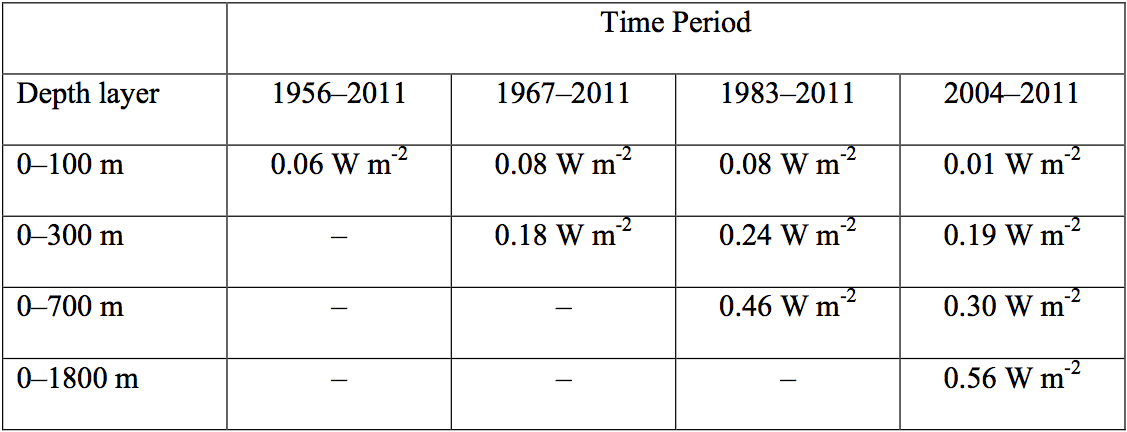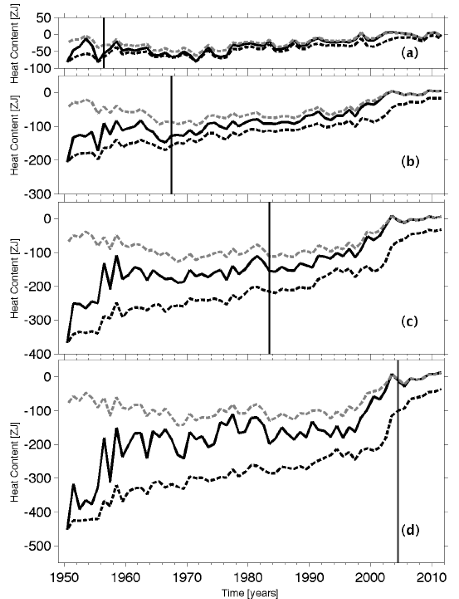
Recently, Georgia Tech climate scientist Judith Curry, along with Texas A&M climate scientist Andrew Dessler, testified before a US Senate committee on the subject of climate change. While Dessler's testimony was excellent and well-supported by the body of scientific evidence, Curry's contained a number of errors (i.e. see the Guardian on global warming attribution, Eli Rabett on Antarctic sea ice, and Tamino on Arctic warming and sea level rise, for starters).
Curry's main and most flawed argument was that information in the latest IPCC report should decrease our confidence in human-caused global warming; an argument she based in large part on the supposed global warming 'pause', which is itself a fictional creation. While the warming of average global surface temperatures has slowed (though not nearly as much as previously believed), the overall amount of heat accumulated by the global climate has not, with over 90 percent being absorbed by the oceans.
A few days after her Senate testimony, Curry took to her blog to dispute these data, essentially arguing that the amount of heat absorbed by the oceans has also 'paused', which would then support her arguments. However, in evaluating the ocean heat content data and scientific literature, Curry made a number of mistakes. This gives us an excellent opportunity to properly evaluate the science on rising ocean heat content and see what it tells us. The key points are:
The following quote from her blog articulates Curry's primary misunderstanding on the subject of rising ocean heat content.
"The only data set that appears to provide support for ocean sequestration is the ocean reanalysis ... All in all, I don’t see a very convincing case for deep ocean sequestration of heat."
The ocean reanalysis Curry refers to is Balmaseda et al. (2013). A ‘reanalysis’ is a climate, ocean or weather model simulation of the past that incorporates data from historical observations. However, as we recently discussed, the increase in deep ocean heat content is a robust result in data sets that do not include reanalysis. In fact, in her blog post Curry discusses a new paper by Lyman & Johnson (2013) that directly contradicts her assertion. The paper relies on observational, not reanalysis data, and concludes,
"In recent years, from 2004 to 2011, while the upper ocean is not warming, the ocean continues to absorb heat at depth (e.g., Levitus et al. 2012; von Schuckman and Le Traon 2011), here estimated at a rate of 0.56 W m-2 when integrating over 0–1800 m."
The paper also includes this useful table illustrating that according to observational data, ocean heat content has indeed accumulated rapidly in the deep oceans in recent years. Of the heat accumulating in the upper 1,800 meters of oceans for 2004–2011, 46 percent was sequestered in the deep oceans (below 700 meters).
To be clear, there's nothing wrong with using reanalysis data. In fact, the Balmaseda et al. (2013) fills in gaps in observations most comprehensively by utilizing all kinds of data as well as using ocean models. The fact that they're able to resolve volcanic eruptions and El Niño events suggests that the reanalysis may be more accurate than purely observational data sets that cannot resolve these events. However, the key point here is that the observational data, including Curry's own reference, contradict her point by finding substantial deep ocean heat sequestration over the past decade.
Another problem with Curry's analysis is that she simply eyeballs the ocean heat content graph in Lyman & Johnson (2013) and concludes that since 2003, the data look flat.

Time series of annual average global integrals of upper ocean heat content anomaly (1021 J, or ZJ) for (a) 0–100 m, (b) 0–300 m, (c) 0–700 m, and (d) 0–1800 m. Thin vertical lines denote when the coverage (Fig. 3) reaches 50% for (a) 0–100 m, (b) 100–300 m, (c) 300–700 m, and (d) 900–1800 m. From Lyman & Johnson (2013)
Scientists don't rely on their eyeballs because our senses can introduce bias and deceive us. The data in the figure above may look relatively flat after 2003, but as the table above shows, they are not. For 2004–2011, the data show the oceans accumulating heat at a rate of 0.19 W/m2 (3x1021 J/yr) in the upper 300 meters, 0.30 W/m2 (5x1021 J/yr) in the upper 700 meters, and 0.56 W/m2 (9x1021 J/yr) in the upper 1,800 meters. The latter number is equivalent to 4.5 Hiroshima atomic bomb detonations per second – a far cry from a global warming 'pause'.
We also know from satellite observations that the planet is accumulating heat due to a global energy imbalance (measured at the top of the atmosphere). A new paper by Trenberth et al. (2014) notes that the amount of heat accumulating in the global climate (most of which is absorbed by the oceans) is generally consistent with the observed global energy imbalance (see the previous post for further details). If the ocean were to stop warming as Curry suggests, it would require an explanation of where the energy from the global imbalance is going.
Curry also suggests that because they're not globally uniform, recent changes in ocean heat content "most likely reflects natural internal variability. It doesn’t look like an AGW signal." Again, if heat were simply shifting between ocean basins naturally, it would require an explanation of where the energy from the global imbalance is going. The problem with breaking the data out into individual ocean basis as Curry does is that it's easy to then lose sight of the global picture. The oceans as a whole are building up a lot of heat. That long-term global ocean heat buildup has to be caused by an external forcing like the increased greenhouse effect. The oceans aren't just going to naturally start accumulating zetajoules of heat – that heat has to come from somewhere.
As for the variation in heat content gain in each basin; this is no great surprise, as there is an exchange of water masses between the ocean basins. Most of the deep ocean warming is occurring in the subtropical ocean gyres - vast rotating masses of water in each ocean basin where near-surface currents converge and are forced downward into the ocean interior. When the tropical easterly trade winds strengthen, as they have from the year 2000 onwards, this whole wind-driven ocean circulation becomes more vigorous, the South Pacific subtropical gyre spins up, and the western arm of the gyre exports more tropical water through the Indonesian archipelago into the Indian Ocean. Likewise, the more vigorous ocean circulation forced by stronger trade winds forces more heat to be exported from the Indian Ocean, around the southern tip of Africa, into the South Atlantic.
Although it cannot be discounted that long-term warming is affecting this circulation in some way, a large part of this recent behavior is likely to be natural variation associated with the vigorous or sluggish phases of the ocean circulation. Whenever the wind-driven ocean circulation switches phase in the future, the current basin-scale warming pattern will change. Weak export of tropical water out of the Pacific during that phase should see a build-up of heat in the Pacific basin. In other words, what we are seeing is probably natural variability in this circulation against a warming background ocean state forced by the increased greenhouse effect.
Ocean heat content by region in the ORAS4 reanalysis by Balmaseda et al (2013). NXTRP=northern extratropics, SXTRP=southern extratropics, TROP=+/-30° latitude, TRATL=tropical Atlantic, TRPAC=tropical Pacific & TRIND=tropical Indian ocean. Units are in 10 22 Joules. Despite short-term variability in ocean heat content storage, each region has experienced long-term warming.
Curry also argues that the rate of sea level rise during 1930–1950 was similar to that in recent years, according to the IPCC, which suggests that ocean heat content was increasing at a similar rate to today. She then argues that this can't be attributed to human-caused global warming, which presumably implies something about the current rise in ocean heat content.
First, while the early 20th century warming was likely predominantly naturally-caused (i.e. low volcanic activity and increasing solar activity), there was also a significant human contribution as greenhouse gas emissions began to ramp up. Second, according to most estimates, the rate of sea level rise today is higher than the rate during 1930–1950 as shown in the IPCC report and Rahmstorf et al. (2012). Third, tide gauge coverage 70 years ago was not as good as today's, and much of the variability is simply due to noise and factors like coverage bias, as discussed by Rahmstorf et al. (2012) and Tamino.
Fourth and most importantly, the argument is a non sequitur – the conclusion doesn't follow from the premise of the argument. Yes, global warming events have occurred naturally in the past, and sea level rose as a consequence, but that doesn't tell us anything about the causes of the current global warming. This is akin to seeing a dead body with a knife sticking out the back and arguing that it must have been a natural death because people have died naturally in the past.
The bottom line is that all available ocean heat content data show that the oceans and global climate continue to build up heat at a rapid pace, consistent with the global energy imbalance observed by satellites. In recent years, much of that heat has accumulated in the deep oceans. Curry misunderstands the importance of this fact.
"even if the heat from surface heating of the ocean did make it into the deep ocean, presumably the only way for this to happen involves mixing (rather than adiabatic processes), so it is very difficult to imagine how this heat could reappear at the surface in light of the 2nd law of thermodynamics."
Nobody is arguing that the heat sequestered in the deep ocean will suddenly return to the surface. Some fraction of it, from the upper ocean, may reappear as an El Niño event, but some is irreversibly mixed and forms part of the inevitable warming and equilibration of the ocean to a warming climate.
While the warming of global surface temperatures in recent years has slowed in large part due to the more efficient heat transfer to the deep oceans, that can't last forever. When that trend reverses, as past observations suggest it will, we'll experience an acceleration of warming at the Earth's surface.
Posted by dana1981 on Thursday, 30 January, 2014
 |
The Skeptical Science website by Skeptical Science is licensed under a Creative Commons Attribution 3.0 Unported License. |